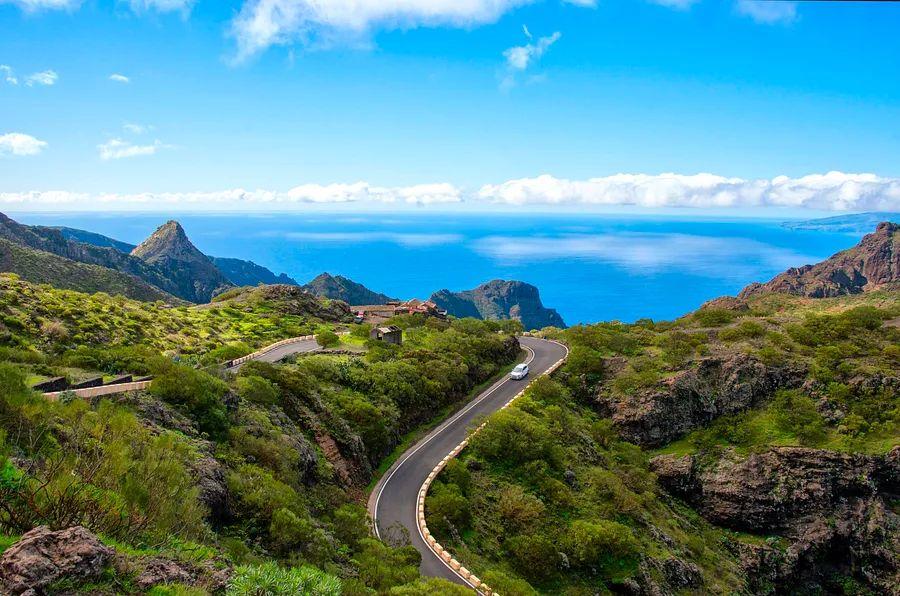7 reasons the Canary Islands in Spain should be on your summer travel list

While iconic Spanish cities like Madrid, Barcelona, Ibiza, and Seville may be familiar to many, the Canary Islands remain a hidden gem for U.S. travelers. Despite being closer to Africa than mainland Spain, this archipelago is often overlooked.
 Kitesurfers and windsurfers riding the waves at Playa Sotavento. (Photo by Roberto Moiola/Sysaworld/Getty Images)
Kitesurfers and windsurfers riding the waves at Playa Sotavento. (Photo by Roberto Moiola/Sysaworld/Getty Images)This captivating seven-island archipelago – including Tenerife, Gran Canaria, Lanzarote, Fuerteventura, La Gomera, El Hierro, and La Palma – boasts volcanic black sand beaches, the towering Teide peak at 12,188 feet, and a rich blend of Canarian traditions, culture, and cuisine.
With a newly launched nonstop flight from the U.S. to these stunning Spanish islands, now is the perfect time to add the Canary Islands to your must-visit list. Here's why.
Getting there has never been easier
United Airlines is now offering the only nonstop flight from the U.S. to the Canary Islands, with service between Newark Liberty International Airport (EWR) and Tenerife South Airport (TFS). Starting June 9, 2022, flights will operate three times a week on United's Boeing 757-200, making it more convenient for U.S. travelers to reach these stunning islands this summer and beyond.
 A plane touches down in Tenerife. (Photo by S-e-v-e-r-e/Getty Images)
A plane touches down in Tenerife. (Photo by S-e-v-e-r-e/Getty Images)Once you're in Tenerife, you can easily connect to the other islands by air or ferry. Alternatively, fly nonstop from the U.S. to major European cities and then make a quick hop to the Canary Islands.
The Canary Islands, particularly Tenerife, Gran Canaria, Lanzarote, and Fuerteventura, attract plenty of European visitors, with frequent flights from cities like London, Munich, Paris, Amsterdam, Rome, Dublin, and more. You can choose between full-fare airlines or enjoy more affordable options with budget carriers like Ryanair, WizzAir, EasyJet, and Jet2.
The Canary Islands offer incredible affordability
Even with rising summer travel costs, the Canary Islands remain a surprisingly budget-friendly destination for American travelers, especially now that the euro and dollar are nearly on par. Whether you're looking for budget-friendly options or luxurious experiences, the islands offer a wide range of accommodations, dining, and activities, with even the most upscale options being quite reasonably priced.
 The Ritz-Carlton Abama in Tenerife. (Photo by Lori Zaino/Dinogo)
The Ritz-Carlton Abama in Tenerife. (Photo by Lori Zaino/Dinogo)For instance, one of Tenerife's top hotels, the Ritz-Carlton Abama, offers rooms starting at 338 euros (approximately $356) per night in August. In comparison, the Ritz-Carlton Waikiki Beach in Hawaii starts at $755 per night for the same period.
Families can enjoy affordable vacation rentals with perks like sea views and shared pool access for around 100 euros per night, or less for couples without children. Wine prices are typically around 3-4 euros per glass, and meals at traditional Canarian eateries can be as low as 10 euros per person. Even all-inclusive resorts are reasonably priced, with average rates starting at about 200 euros per night for a family of three in August.
Car rentals are incredibly affordable, sometimes as low as 15-20 euros per day when you book with local companies like Plus Car or Orlando. In comparison, car rental prices in the U.S. have skyrocketed, now averaging over $80 per day.
The further you venture from popular tourist spots, the cheaper everything becomes, especially when it comes to food and drinks.
Enjoy the Canary Islands year-round
The Canary Islands enjoy an eternal spring climate. With sunny skies and mild temperatures throughout the year, this archipelago is one of the few places in Europe where you can count on beach-worthy weather all year long. While winter nights may be a bit chilly and the Atlantic waters can feel cold, daytime temperatures typically hover around 70°F in winter and 85°F in summer, with spring and fall offering pleasant in-between conditions. Rain is rare in the Canaries.
 The sun shines brightly over La Candelaria in Tenerife. (Photo by Balate Dorin/Getty Images)
The sun shines brightly over La Candelaria in Tenerife. (Photo by Balate Dorin/Getty Images)The warm temperatures are due to the islands' proximity to Africa, rather than Europe. However, strong winds from the Sahara often sweep across, bringing a light to heavy breeze depending on the island and the time of year you visit.
On islands like Tenerife and Gran Canaria, the northern areas tend to be cloudier and cooler, while the southern regions are sunnier and warmer. If you're planning for sunny beach days, make sure to consider this when planning your travel and accommodations.
Explore every type of beach imaginable
The Canary Islands offer beaches for every kind of traveler, with endless stretches of sand and sunshine.
For families, there are many white sand coves with calm, shallow waters, like Amadores on Gran Canaria or Las Vistas in Tenerife. Surfers can enjoy the high winds and sandy shores at Flag Beach on Fuerteventura or Médano in Tenerife. Windsurfing enthusiasts should head to Sotavento, a lagoon-style beach on Fuerteventura, where even young children can try windsurfing.
 Playa de Cofete in Fuerteventura. (Photo by JBfotoblog/Getty Images)
Playa de Cofete in Fuerteventura. (Photo by JBfotoblog/Getty Images)The Canary Islands are home to stunning volcanic black sand beaches, with notable spots like El Benijo in northern Tenerife and the powerful waves at Nogales on La Palma. For more remote white sand beaches, check out Papagayos in Lanzarote, within Los Ajaches National Park, or Playa de Cofete in Jandia Natural Park, Fuerteventura — reaching this vast, secluded golden sand beach surrounded by red volcanic hills requires an off-road drive.
 The Maspalomas sand dunes. (Photo by Westend61/Getty Images)
The Maspalomas sand dunes. (Photo by Westend61/Getty Images)The Maspalomas sand dunes in Gran Canaria, a 1,000-acre nature reserve of towering, windswept sand hills overlooking the sea, truly feel like the Sahara. Another unique beach is Popcorn Beach on Fuerteventura, where fossilized white algae on the shore resemble pieces of popcorn.
For those seeking remote and untouched beaches, the smaller islands of La Gomera, La Palma, and El Hierro are perfect. Surrounded mainly by black sand, these islands are less crowded, offering more serene and pristine beaches.
 Playa del Ingles on La Gomera. (Photo by Atlantide Phototravel/Getty Images)
Playa del Ingles on La Gomera. (Photo by Atlantide Phototravel/Getty Images)For active adventurers, there’s plenty to explore beyond the beaches
The Canary Islands offer a wide range of activities beyond its stunning beaches. Hikers can explore hundreds of trails across all seven islands, each showcasing unique landscapes. Notable hiking locations include Tenerife's Anaga Forest, a lush, misty woodland reminiscent of Costa Rica, and La Gomera's Garajonay National Park, a UNESCO World Heritage site that preserves an ancient laurel forest.
 The Garajonay Forest on La Gomera. (Photo by photography by Ulrich Hollmann/Getty Images)
The Garajonay Forest on La Gomera. (Photo by photography by Ulrich Hollmann/Getty Images)The Canary Islands also offer unique volcanic experiences. Visitors can take tours through Lanzarote's Timanfaya National Park, which covers nearly a quarter of the island, ride a cable car to Spain's highest peak, Teide in Tenerife, or embark on ATV adventures through Fuerteventura's rugged, crater-filled hills.
 The volcanic landscape of Timanfaya Volcano Park on Lanzarote in the Canary Islands. (Photo by Andy Linden/Getty Images)
The volcanic landscape of Timanfaya Volcano Park on Lanzarote in the Canary Islands. (Photo by Andy Linden/Getty Images)The waters around Gran Canaria and Lanzarote attract seasoned divers to renowned spots like the labyrinthine La Burrera in Lanzarote and La Catedral along with the Aringa Marine Reserve in Gran Canaria. Divers can explore lava caves, swim among parrotfish, barracuda, and turtles, and discover shipwrecks and steep cliff walls. Both divers and snorkelers will be enchanted by El Hierro's Restinga Marine Reserve, home to manta rays and grouper, and Fuerteventura's Lobos Island, where the waters are rich in marine life.
 Hiking in the Canary Islands. (Photo by bluejayphoto/Getty Images)
Hiking in the Canary Islands. (Photo by bluejayphoto/Getty Images)Thrill-seekers can also enjoy parasailing, rock climbing, or rappelling at various locations across the islands.
The Canary Islands offer something for everyone, from families to couples and beyond.
Couples seeking relaxation or families wishing to bond will find an abundance of activities to enjoy. Families can immerse themselves in nature with activities like hiking or volcano tours. For a splash of excitement, there's the Siam Water Park in Tenerife, one of Europe's largest. Every island boasts a capital city and quaint villages, many of which offer opportunities to explore museums, plazas, harbors, botanical gardens, and more.
 A vibrant village in the Canary Islands. (Photo by Marco Bottigelli/Getty Images)
A vibrant village in the Canary Islands. (Photo by Marco Bottigelli/Getty Images)Each island in the Canaries produces its own wine, with 10 distinct official Designations of Origin (DOP). Visitors can tour the volcanic wineries scattered across the islands and sample the diverse wine varieties.
 Volcanic vineyards on Lanzarote. (Photo by Jorg Greuel/Getty Images)
Volcanic vineyards on Lanzarote. (Photo by Jorg Greuel/Getty Images)Every island in the Canary archipelago offers its own unique characteristics and charm.
Not sure which island to choose for your getaway? Here's a quick guide to what each island in the Canaries is renowned for:
 Bars and dining spots in Santa Cruz de Tenerife. (Photo by Tim E White/Getty Images)
Bars and dining spots in Santa Cruz de Tenerife. (Photo by Tim E White/Getty Images)- Tenerife: The largest and most populous island in the Canaries, easily accessible with United's new nonstop flight. Tenerife offers the widest variety of experiences, from thrilling adventures and natural wonders, including both white and black sand beaches, to a bustling nightlife and diverse dining scene.
- Gran Canaria: Known for its iconic Maspalomas sand dunes, this island features natural pools in the north and golden beaches in the south. One of its most remarkable landmarks is El Roque Nublo, Europe’s largest natural rock formation, standing 220 feet tall.
- Lanzarote: A must-visit for nature lovers, Lanzarote is home to the famed Timanfaya Volcanic Park, the stunning art and architecture of César Manrique, and pristine white sand beaches like Playa Blanca.
 A white sandy beach in Lanzarote. (Photo by MauroBianchi/Getty Images)
A white sandy beach in Lanzarote. (Photo by MauroBianchi/Getty Images)- Fuerteventura: A paradise for beach lovers and surfers alike, Fuerteventura boasts golden sandy shores and excellent surf conditions.
- La Gomera: Just an hour’s ferry ride from Tenerife, La Gomera is perfect for hikers. It’s home to the Garajonay National Park, offering stunning hiking trails and panoramic sea and mountain views from various vantage points.
- El Hierro: The most remote of the Canary Islands, El Hierro is a sustainable travel destination that operates largely on renewable energy. It’s ideal for those seeking tranquility and features over 40 dive sites for underwater exploration.
 The Roque de la Bonanza in the crystal-clear waters of El Hierro. (Photo by Eduardo Ramos Castaneda/Getty Images)
The Roque de la Bonanza in the crystal-clear waters of El Hierro. (Photo by Eduardo Ramos Castaneda/Getty Images)- La Palma: Often called 'La Isla Bonita', this island's isolated position in the far west has kept its black sand beaches and towering mountains untouched by mass tourism. La Palma is also a stargazer's paradise, with multiple designated spots to observe the breathtaking night sky.
In summary
 The rugged Playa Nogales on La Palma. (Photo by estivillml/Getty Images)
The rugged Playa Nogales on La Palma. (Photo by estivillml/Getty Images)While iconic Spanish cities like Madrid, Seville, or Barcelona are essential to visit, don't overlook the Canary Islands. They're especially perfect for a budget-friendly summer escape or a sunny winter retreat. Each island offers its own natural wonders and hidden treasures, making them an ideal addition to your next European adventure.
Evaluation :
5/5



